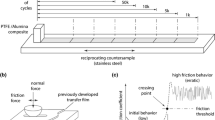Abstract
Polydimethylsiloxane (PDMS) films were prepared on silicon wafers by spin coating. The tribological properties of the PDMS films sliding against AISI-52100 steel ball were investigated with a dynamic static friction coefficient measurement apparatus in a ball-on-plate configuration. It was found that crosslinking, end grafting, and chemical characteristics of the substrate surfaces combined to play an important role in keeping the films’ stability and improving the friction-reduction and wear-resistant properties. It was also noted that crosslinked PDMS films on hydroxylated substrates exhibited the most stable friction coefficient and the longest antiwear life, while a friction coefficient below 0.01 was observed for the crosslinked PDMS films on hydrophobic substrates. The latter might be attributed to the weak interaction at the interface of PDMS layer and the self-assembled monolayer. The friction coefficient appeared to be velocity dependent. At higher sliding velocities, the films showed more stable and smaller friction coefficients; this might be attributed to the shear thinning effect.
Similar content being viewed by others
References
J.M. Zeigler and F.W.G. Fearon, Silicon-Based Polymer Science (Am. Chem. Soc., Washington, DC, 1990).
H. Hillborg, M. Sandelin, and U.W. Gedde, Polymer 42, 7349 (2001).
M.J. Owen, Comm. Inorg. Chem. 7, 195 (1988).
B. Bushan, Handbook of Micro/Nano Tribology, 2nd ed. (CRC, Boca Raton, FL, 1999).
N. Barie, M. Rapp, and H.J. Ache, Sens. Actuators B. 46, 97 (1998).
A.C. Dieng, L. Lavielle, and G. Riess, New Polym. Mater. 5, 13 (1996).
N. Sokol, J. Patric, B.L. Niels, and A. Kristoffer, Langmuir 15, 3859 (1999).
H.R. Brown, Science 263, 1411 (1994).
A. Casoli, M. Brendle, J. Schultz, P. Auroy, and G. Reiter, Langmuir 17, 388 (2001).
F. Schreiber,Prog. Surf. Sci. 65, 151 (2000).
H. Shin, J.U. Jeon, Y.E. Pak, H. Im, and E.S. Kim, J. Mater. Res. 16, 564 (2001).
L.G. Britcher, D.C. Kehoe, J.G. Matisons, R.St.C. Smart, and A.G. Swincer, Langmuir 9, 1609 (1993).
E. Manias, G. Hadziioannou, and G. ten Brinke, Langmuir 12, 4587 (1996).
E. Manias, I. Bitsanis, G. Hadziioannou, and G. ten Brinke, Europhys. Lett. 33, 371 (1996).
K. B. Migler, H. Hervet, and L. Leger, Phys. Rev. Lett. 70, 287 (1993).
E.D. Brown, in CRC Handbook of Lubrication and Tribology, edited by E.R. Boser (CRC, Boca Raton, FL, 1994), p. 308.
Author information
Authors and Affiliations
Rights and permissions
About this article
Cite this article
Liu, W., Zhou, F., Yu, L. et al. Preparation and tribological investigation of thin silicone films. Journal of Materials Research 17, 2357–2362 (2002). https://doi.org/10.1557/JMR.2002.0345
Received:
Accepted:
Published:
Issue Date:
DOI: https://doi.org/10.1557/JMR.2002.0345



